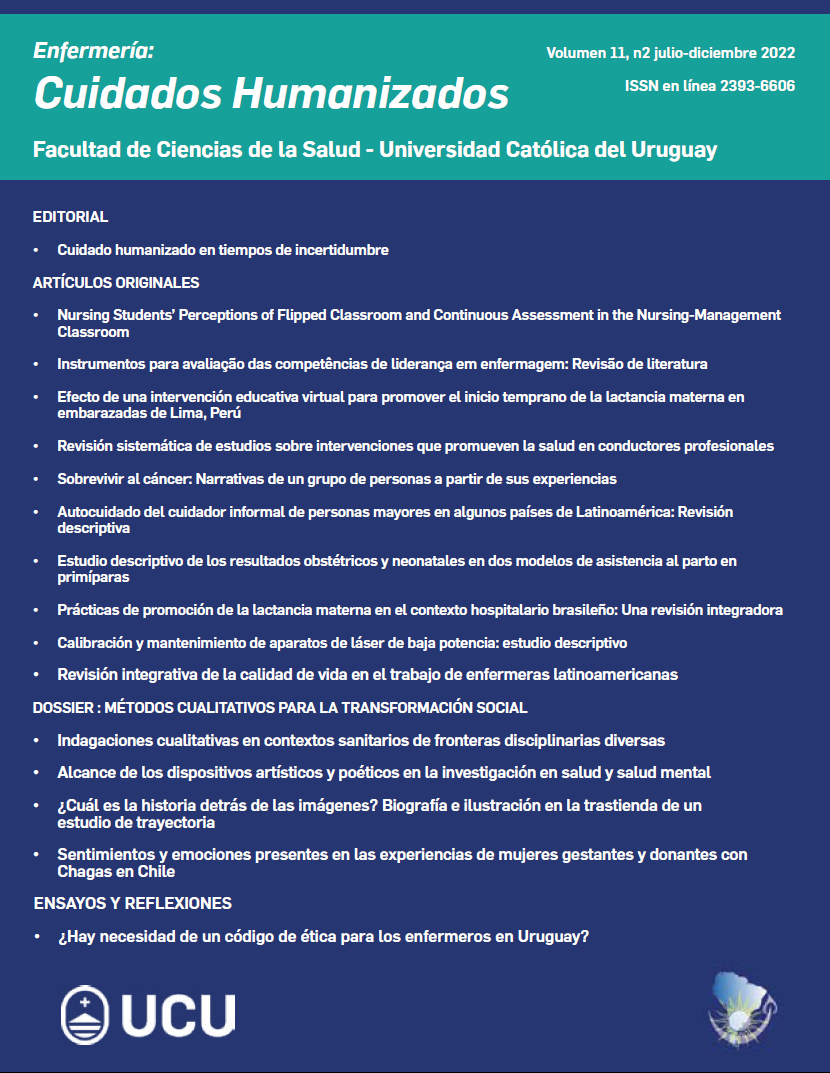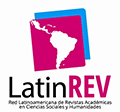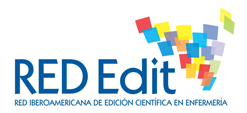Nursing Students’ Perceptions of Flipped Classroom and Continuous Assessment in the Nursing-Management Classroom
DOI:
https://doi.org/10.22235/ech.v11i2.2833Keywords:
nursing education, educational measurement, flipped classroom, organization and administration, personal satisfactionAbstract
Introduction: Although the training of nurses in administration and leadership has an important repercussion on the present and the future of the profession, teaching methods are still traditional in many cases. Flipped classroom is a widely used method in nursing education but studies about its application to Nursing Administration and Management are limited. Method: Qualitative study by means of anonymous survey (dichotomous and open questions). Results: 92 % of students were shown to be satisfied with the teaching methodology and 92.9 % with the assessment. Only 31.5 % had used it previously but 83 % would like to use it in more subjects. The students showed that the methodology used had improved their opinion about the content and had increased their perception its usefulness. Conclusion: The participating students have been shown to be satisfied with flipped method and continuous assessment. These teaching strategies can help motivate nursing students towards the subject of Nursing Administration and Management, which can encourage them to pursue postgraduate training and professional practice in this area.Downloads
References
Pavlidis G, Downs C, Kalinowski TB, Swiatek‐Barylska I, Lazuras L, Ypsilanti A, Tsatali M. A survey on the training needs of caregivers in five European countries. Journal of Nursing Management. 2020;28(2):385-98. DOI: 10.1111/jonm.12940
De Lange W, Kars MC, Poslawsky IE, Schuurmans MJ, Hafsteinsdóttir TB. Postdoctoral nurses’ experiences with leadership and career development: a qualitative study. Journal of Nursing Scholarship. 2019;51(6):689-98. DOI: 10.1111/JNU.12519
Simas TA, Cain JM, Milner RJ, Meacham ME, Bannon AL, Levin LL, Amir N, Leung K, Ockene JK, Thorndyke LE. A systematic review of development programs designed to address leadership in academic health center faculty. Journal of Continuing Education in the Health Professions. 2019;39(1):42-8. DOI: 10.1097/CEH.0000000000000229
Kalaian SA, Kasim RM. Effectiveness of various innovative learning methods in health science classrooms: a meta-analysis. Advances in Health Sciences Education. 2017;22(5):1151-67. DOI: 10.1007/s10459-017-9753-6
Barbour C, Schuessler JB. A preliminary framework to guide implementation of The Flipped Classroom Method in nursing education. Nurse Education in Practice. 2019;34:36-42. DOI: 10.1016/J.NEPR.2018.11.001
Imbernón F, Medina JL. Participative Methodology in the university classroom. Student’s participation. 1st. ed. Science Education Institute, University of Barcelona: Octaedro; 2008.
García-Carpintero E. El portafolio como metodología de enseñanza-aprendizaje y evaluación en el practicum: percepciones de los estudiantes. REDU. Revista de Docencia Universitaria. 2017;15(1):241-57.
Fernández-Martínez E, Gómez del Pulgar M, Rivero Martínez M, Pedraza Anguera AM, Onieva Zafra MD, Beneit Montesinos JV. Una rúbrica evaluadora de competencias investigadoras en residentes de enfermería obstétrico-ginecológica: desarrollo y validación de contenido. NURE Inv. 2018,15(94):1-10.
González-Sanz JD, Barquero-González A, Feria-Lorenzo DJ, León-López R, Martín-Almenta R. Aprender comunicando: una práctica docente innovadora en comunicación científica. Teoría de la Educación. Educación y Cultura en la Sociedad de la Información. 2012;13(3):162-175. DOI: 10.14201/eks.9136
Rodger D, Stewart-Lord A. Students’ perceptions of debating as a learning strategy: A qualitative study. Nurse Education in Practice. 2020;42:102681. DOI: 10.1016/j.nepr. 2019.102681
Ibáñez Masero O, González-Sanz JD. El Blog como herramienta promotora de un aprendizaje enfermero más significativo. Index de Enfermería. 2012;21(1-2):74-76. DOI: 10.4321/S1132-12962012000100016
Cockett A, Jackson C. The use of assessment rubrics to enhance feedback in higher education: An integrative literature review. Nurse Education Today. 2018;69:8-13. DOI: 10.1016/J.NEDT. 2018.06.022
Williams R. Student nurses’ perceptions of the importance of their Practice Assessment Record (PAR): A qualitative study. Nurse Education Today. 2018;71:220-5. DOI: 10.1016/j.nedt. 2018.09.023
Ten Hoeve Y, Castelein S, Jansen G, Roodbol P. Dreams and disappointments regarding nursing: Student nurses’ reasons for attrition and retention. A qualitative study design. Nurse Education Today. 2017;54:28-36. DOI: 10.1016/J.NEDT.2017.04.013
Im S, Jang SJ. Effects of a clinical practicum using flipped Learning among undergraduate nursing students. Journal of Nursing education. 2019;58(6):354-6. DOI: 10.3928/01484834-20190521-06
Scammell JM, Apostolo JL, Bianchi M, Costa RD, Jack K, Luiking ML, Nilsson S. Learning to lead: A scoping review of undergraduate nurse education. Journal of Nursing Management. 2020;28(3):756-65. DOI: 10.1111/JONM.12951
Francl TJ. Is flipped learning appropriate. Journal of Research in Innovative Teaching. 2014;71:119-128.
Oh J, Kim SJ, Kim S, Vasuki R. Evaluation of the effects of flipped learning of a nursing informatics course. Journal of Nursing Education. 2017;56(8):477-83. DOI: 10.3928/01484834-20170712-06
Boruff R. Nursing Students Choose Their Own Role in a Flipped Classroom Approach. Innovative Learning Activities. Journal of Nursing Education. 2018;57(7):450. DOI: 10.3928/01484834-20180618-13
Bingen HM, Steindal SA, Krumsvik R, Tveit B. Nursing students studying physiology within a flipped classroom, self-regulation and off-campus activities. Nurse Education in Practice. 2019;35:55-62. DOI: 10.1016/J.NEPR.2019.01.004
Gubrium JF, Holstein JA, Marvasti AB, McKinney KD. The Sage handbook of interview research: The complexity of the craft. 2nd ed. Sage Publications; 2012.
El-Banna MM, Whitlow M, McNelis AM. Flipping around the classroom: accelerated Bachelor of Science in Nursing students' satisfaction and achievement. Nurse Education Today. 2017;56:41-6. DOI: 10.1016/J.NEDT.2017.06.003
Graneheim UH, Lundman B. Qualitative content analysis in nursing research: concepts, procedures and measures to achieve trustworthiness. Nurse Education Today. 2004;24(2):105-12. DOI:10.1016 / j.nedt.2003.10.001
Rozas MR, Costa J. Autoevaluación del aprendizaje en enfermería con ejercicios interactivos del pograma Hot Potatoes. Educación Médica. 2008;11(1):19-27.
Lewis, P., Hunt, L., Ramjan, L.M., Daly, M., O’Reilly, R., & Salamonson, Y. Factors contributing to undergraduate nursing students' satisfaction with a video assessment of clinical skills. Nurse Educ Today. 2020;84:104-244. DOI: 10.1016/j.nedt.2019.104244
Lavoie‐Tremblay M, Sanzone L, Aubé T, Bigras C, Cyr G, Primeau G. A university/healthcare in4titution mentorship programme: Improving transition to practice for students. Journal of Nursing Management. 2020;28(3):586-94. DOI: 10.1111/jonm.12960
Betihavas V, Bridgman H, Kornhaber R, Cross M. The evidence for ‘flipping out’: a systematic review of the flipped classroom in nursing education. Nurse Education Today. 2016;38:15-21. DOI: 10.1016/J.NEDT.2015.12.010
Huang HL, Chou CP, Leu S, You HL, Tiao MM, Chen CH. Effects of a quasi-experimental study of using flipped classroom approach to teach evidence-based medicine to medical technology students. BMC Medical Education. 2020;20(1):1-9. DOI: 10.1186/s12909-020-1946-7
Oliver R, Luther L. Flipping the graduate nursing classroom: an integrative review. Journal of Nursing Education. 2020;59(6):305-10. DOI: 10.3928/01484834-20200520-02.
Green RD, Schlairet MC. Moving toward heutagogical learning: Illuminating undergraduate nursing students' experiences in a flipped classroom. Nurse Education Today. 2017;49:122-8. DOI: 10.1016/j.nedt.2016.11.016
Finnegan AP, Di Lemma L, Moorhouse I, Lambe RE, Soutter EM, Templeman J, Ridgway V, Hynes C, Simpson R, McGhee S. Educating nurses to deliver optimum care to military veterans and their families. Nurse Education in Practice. 2020;42:102654. DOI: 10.1016/J.NEPR.2019.102654
Das A, Lam TK, Thomas S, Richardson J, Kam BH, Lau KH, Nkhoma MZ. Flipped classroom pedagogy: Using pre-class videos in an undergraduate business information systems management course. Education + Training. 2019;61(6):756-774. DOI: 10.1108/ET-06-2018-0133
Joyce BL, Harmon MJ, Johnson RG, Hicks V, Brown‐Schott N, Pilling LB. Using a quality improvement model to enhance community/public health nursing education. Public Health Nursing. 2019;36(6):847-55. DOI: 10.1111/phn.12656
Fernández-Ponce C, Arbulo-Echevarría M, Muñoz-Miranda JP, Aguado E, García-Cózar F. Análisis de la evaluación continua en el contexto del EEES. Revista Docencia e Investigación. 2017;1(27):81-100.
Craft JA, Christensen M, Shaw N, Bakon S. Nursing students collaborating to develop multiple-choice exam revision questions: A student engagement study. Nurse Education Today. 2017;59:6-11. DOI: 10.1016/j.nedt.2017.08.009
Liu YQ, Li YF, Lei MJ, Liu PX, Theobald J, Meng LN, Liu TT, Zhang CM, Jin CD. Effectiveness of the flipped classroom on the development of self-directed learning in nursing education: a meta-analysis. Frontiers of Nursing. 2018;5(4):317-29.
Downloads
Published
How to Cite
Issue
Section
License
Copyright (c) 2022 Enfermería: Cuidados Humanizados

This work is licensed under a Creative Commons Attribution 4.0 International License.

















